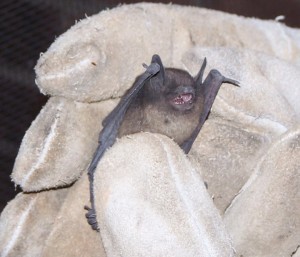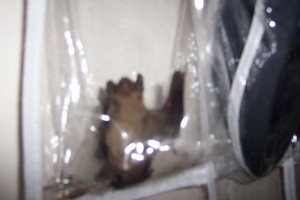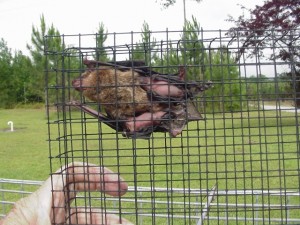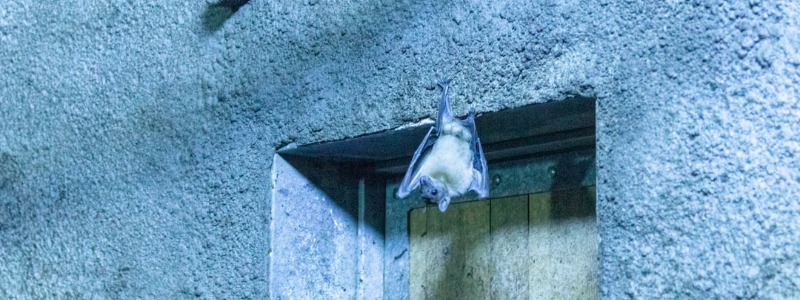Removing bats can be a tricky process, especially since bats are occasionally protected during certain months of the year. However, no matter when you are doing it, bat removal can be a tedious process that may take weeks to fully be completed.
Bats are one of the most beneficial animals to humans, but they may be facing yet another threat in addition to white-nose syndrome. At this time, the potential transmission from humans with the COVID-19 virus to North American bats remains unknown. Researchers are investigating the susceptibility of North American bats to the COVID-19 virus. source
You will want to first identify what entrance they are using as their main entry point, it is crucial to not seal this until the bats are evicted completely. You can, however, seal all other entrances, which will prevent the roost from growing. You can install a one-way valve on the main access point. This valve will not harm the bats but is merely a chute for them so that they can leave the roost but are not able to come back in. You should put a slick material – like plastic – at the end of the valve, which is what prevents the bats from being able to get a good enough grip to pull themselves back in. When they are not able to get back into their roosting area, they likely will move onto a new place to try and roost.
 Excluding your home, or sealing up your home, is tricky when it comes to dealing with bats. They are able to fit into extremely small holes as it is, and if you have a barrel tile roof they are able to fit under each raised tile. So, it is important to seal all holes up that bats could potentially use to gain entry. Once all bats have been evicted from the attic, you will also be able to pull out the one-way valve and seal that hole as well. Meaning that your home should now be completely bat-proof.
Excluding your home, or sealing up your home, is tricky when it comes to dealing with bats. They are able to fit into extremely small holes as it is, and if you have a barrel tile roof they are able to fit under each raised tile. So, it is important to seal all holes up that bats could potentially use to gain entry. Once all bats have been evicted from the attic, you will also be able to pull out the one-way valve and seal that hole as well. Meaning that your home should now be completely bat-proof.
Finally, you should be ready for the sanitation. While this is disgusting and definitely the “dirty work” of the entire process, it is also important to keep you from getting sick from any remaining bacteria in the area. You should use thick protective gloves and wear a face mask when dealing with guano. When you remove the guano, dispose of it immediately. After all, guano has been removed, go over the entire area with a disinfectant that will break down the remaining bacteria. This process will also help eliminate any odor that may be left behind as well.
How to Catch and Remove a Bat in Your Home
While uncommon, you may at some point find a lone bat flying in the living space of your home. The removal process in this instance is actually very simple, just make sure that you have the proper protective gear – such as thick gloves and long sleeves/pants. These will all protect you, should the bat feel threatened, and bite you. You can use a small net or a towel to catch the bat, this way you are not ever directly touching it.
 You should close all doors and entrances to the room so that the bat is not flying from room to room. You can then wait until the bat lands on a surface you can easily reach, then simply reach out and grab it with the net or towel. If using a towel, apply just enough pressure to keep him still while not harming him in any way. Once you have successfully captured the bat you can bring him outside, where hopefully he will just take off and fly away. If not, you can place him on a tree where he can then climb up to where he feels comfortable taking off.
You should close all doors and entrances to the room so that the bat is not flying from room to room. You can then wait until the bat lands on a surface you can easily reach, then simply reach out and grab it with the net or towel. If using a towel, apply just enough pressure to keep him still while not harming him in any way. Once you have successfully captured the bat you can bring him outside, where hopefully he will just take off and fly away. If not, you can place him on a tree where he can then climb up to where he feels comfortable taking off.
After the bat is successfully removed from the premises, you should then double-check to make sure that your lone guest was ACTUALLY alone. If this is your first encounter with a bat, you are more than likely safe and he just got separated from his group somehow. However, it is important to double-check to make sure, as well as go over your home and find out how he got in in the first place. On the other hand, if you have been experiencing bat issues then you want to find how he got from the attic to the living space, and fix it immediately. This will prevent any other bats from being able to come in as well.
Removing a Bat from a Chimney
We spend all December preparing our chimney for a big man in a red suit to come down it, but the idea of a bat flying down the chimney is not as appealing. Your chimney is actually the next option for bats, if they cannot get into the attic or if the attic space gets too full. While the process for getting bats out of your chimney is very similar to getting bats out of your attic there is one extra very important step: Make sure you do not light fires while bats are living in your chimney.
 When you are going about sealing up any access points, you should make sure that the damper on the chimney is closed. This will keep bats from being able to fly into the living area of your home. When dealing with bats in the chimney, you should also look into installing a chimney cap to keep bats from entering or exiting the top of the chimney. Most commonly, when bats are in your chimney you are dealing with a maternity roost. More than likely, you will have infants in the chimney which means that you must wait until they are able to fly to completely seal off the chimney.
When you are going about sealing up any access points, you should make sure that the damper on the chimney is closed. This will keep bats from being able to fly into the living area of your home. When dealing with bats in the chimney, you should also look into installing a chimney cap to keep bats from entering or exiting the top of the chimney. Most commonly, when bats are in your chimney you are dealing with a maternity roost. More than likely, you will have infants in the chimney which means that you must wait until they are able to fly to completely seal off the chimney.
Since there is probably guano in your chimney now, you should probably contact a professional to help clean it out. This just ensures that the guano is completely removed and there are no leftovers remaining that could still cause health issues.
Why Hire A Professional?
Wildlife removal is an arduous task, and not for the squeamish. From trapping the animals to cleaning up solid and liquid animal waste to restoring your home to brand-new condition–we’ve got you covered. No task too big or too small for our team!

